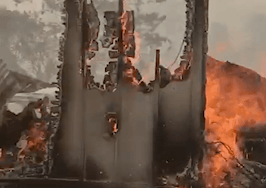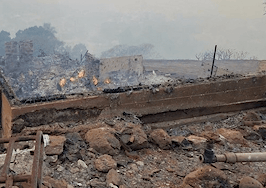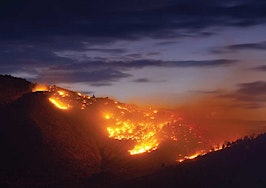Housing in beautiful wine country was already scarce before flames ravaged 245,000 acres across Northern California and burned down 5,700 structures in their path. According to a new report from Pacific Union International, real estate agents in the region are already witnessing the effects of heightened demand.
The firestorm has wreaked more devastation –$4 billion worth of damage and at least 42 lives lost — than the San Francisco Bay Area’s last major wildfire 26 years ago in Oakland. The 1991 fire and restoration offer insights into the challenges ahead and the strategies for handling them that worked in the past, such as streamlining city and county permit processes to expedite rebuilding.
“There are many lessons to learn from the Oakland Hills fire, and many comparable stories will emerge from the disaster in the wine country,” said Pacific Union Chief Economist Selma Hepp.
The recovery in Oakland began around six months after the fires and took about four years, although not all units were rebuilt, according to U.S. census data.
Some of those who did rebuild took the opportunity to construct larger properties with five- and six-bedrooms and three-car garages compared to their humbler predecessors. Others sold their charred land to investors, who built massive homes that are now selling at multimillion-dollar prices. Today, the median home value in these neighborhoods exceeds $1 million, compared to $300,000 at the time.
What will be the longer-term impact on the wine country economy and housing markets? As the Oakland Hills’ experience and other California wildfires have shown, it takes communities about a year to return to some level of normalcy.
Unlike Houston, which was battered by Hurricane Harvey in August, California has in general been under-supplied with new housing for decades. The Golden State’s supply gap is at 2 million units, and that number is projected to increase to 3.5 million by 2025, according to an analysis by the McKinsey Global Institute.
The city of Santa Rosa in Sonoma County alone lost 5 percent of its housing stock to the fires. With current rate of new construction at 1,200 new housing units built in Sonoma County per year, it would take about 2.5 years to replace the 2,800 properties that have been destroyed by the wildfires in Santa Rosa.
Anecdotally, Pacific Union agents are seeing insurance companies willing to pay exorbitant prices for rental units in the North Bay. One Pacific Union listing that previously rented for $4,000 per month received an offer for $13,000 per month from an insurance firm in recent days. Another listing attracted offers of $18,000 per month. Demand in neighboring Marin country communities was also substantially up, the company reported.
And that demand isn’t expected to wane — it’s anticipated that 1,800 households will migrate to Sonoma and Napa in 2017 in addition to those who will need to be re-housed after losing their home.
“Sonoma and Napa counties are some of the most desirable locations to live in the state, and the persistent demand over the years has shown that people are often willing to take a risk to live in a beautiful location, even if the property insurance comes at a higher cost,” said Hepp, adding that existing Sonoma and Napa county residents have already shown incredible resilience, optimism and a desire to rebuild their communities.












